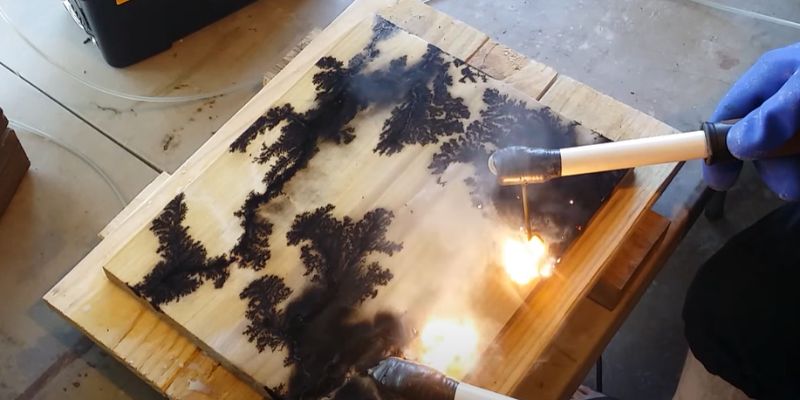Yes, electricity can travel through wood due to the presence of free electrons in its structure. Wood is considered to be a natural insulator, but it still contains small amounts of moisture which allows for the flow of electricity.
Additionally, wood is not a perfect insulator, so it can conduct electricity to some extent. Understanding the behavior of electricity in different materials is important for various applications, such as electrical wiring and safety precautions. We will explore the conductivity of wood and explain how electricity can pass through it.
Furthermore, we will discuss the factors that influence the flow of electricity in wood and the potential risks associated with this phenomenon.
The Conductivity Of Wood
Electricity is capable of traveling through wood, albeit at a lower rate compared to metals and conductive materials due to the wood’s resistance. The natural moisture content and the type of wood contribute to its conductivity, allowing for electrical transmission.
Is Wood A Conductor Or An Insulator?
Wood, which is commonly known for its use in construction and furniture, has long been perceived as an insulator. However, it is essential to explore the conductivity of wood and determine whether it can also serve as a conductor of electricity.
Factors Affecting Wood’s Conductivity
Several factors influence the conductivity of wood:
- Moisture content: The moisture within wood plays a significant role in determining its conductivity. Wet or damp wood conducts electricity better than dry wood due to the presence of free ions in the moisture.
- Species of wood: Different tree species have varying levels of inherent conductivity. For instance, softwoods tend to have higher electrical conductivity than hardwoods.
- The direction of current flow: Wood may exhibit different conductivity levels depending on the direction of electrical current passing through it. It is essential to consider both longitudinal and transverse conductivity when analyzing wood as a conductor.
- Thickness and grain orientation: The thickness and grain orientation of wood also impact its conductivity. As electrical currents follow the path of least resistance, wood with a higher density, such as heartwood, may hinder the flow of electricity compared to sapwood.
- Treatment and coatings: The presence of surface treatments or coatings on wood can significantly alter its conductivity. For instance, painted or laminated wood may have reduced conductivity due to the insulating properties of the coating materials.
Understanding the conductivity of wood is crucial not only for electrical safety but also for various applications in the fields of engineering and design. By considering the aforementioned factors, one can assess whether wood can effectively conduct electricity or if it remains primarily as an insulating material.

The Science Behind Electricity And Wood
Electricity is capable of traveling through wood due to its conductive properties, allowing it to flow along the wood’s grain. This fascinating phenomenon is a result of the wood’s moisture content and the movement of ions within the material.
Electricity is a fascinating force that powers much of our modern world. It flows effortlessly through conductive materials, allowing us to power our devices and light up our homes. But what about wood? Can electricity travel through this natural material? In this section, we will explore the science behind electricity and wood, delving into the concept of electrical conductivity and understanding wood’s molecular structure and its impact on conductivity.
Understanding Electrical Conductivity
Electrical conductivity refers to the ability of a material to conduct electricity. Metals, such as copper and aluminum, are excellent conductors due to their free-flowing electrons. On the other hand, insulators like rubber and plastic hinder the movement of electrons, making it difficult for electricity to pass through them. When it comes to wood, it falls somewhere in between.
Wood’s Molecular Structure And Conductivity
Wood is primarily made up of cellulose, hemicellulose, and lignin, which are complex organic compounds consisting of carbon, hydrogen, and oxygen atoms. These compounds give wood its unique properties, such as strength, flexibility, and resistance to decay. However, when it comes to electrical conductivity, wood has limited potential.
While wood does contain some moisture, a crucial factor for electrical conductivity, it is still considered an insulator. The tightly bound molecular structure of wood restricts the movement of electrons, hindering the flow of electricity. Additionally, the presence of lignin, which acts as an electrical insulator, further limits wood’s conductivity.
In conclusion, while wood is not a good conductor of electricity, it can still store a certain amount of static charge. This property can lead to phenomena like electrostatic discharge and static electricity, but it is not suitable for transmitting or conducting electricity in a practical sense.
In summary, the science behind electricity and wood shows that wood’s molecular structure and its limited electrical conductivity make it an insulator rather than a conductor. Understanding the properties of materials like wood helps us better comprehend how electricity behaves, inspiring further innovation and technological advancements in our quest for efficient energy transmission.
Practical Implications
Wood In Electrical Installations
Wood is commonly used in construction and can be present in electrical installations. While wood is not a conductor of electricity, it can still pose risks in electrical systems. In certain situations, wood can be a part of the grounding system, and its moisture content and condition can impact its ability to safely contain electrical wiring.
Safety Considerations
When utilizing wood in electrical installations, it’s important to consider various safety aspects. Ensuring the proper insulation and grounding of electrical wiring that comes into contact with wood is essential to prevent potential hazards. Additionally, regular assessments of the wood’s condition and moisture level should be conducted to maintain the safety of the electrical system.
Historical And Cultural Perspectives
When examining the subject of whether electricity can travel through wood, it is essential to consider the historical and cultural perspectives that have shaped our understanding of this phenomenon. Throughout history, wood has played a significant role in early electrical applications, as well as holding symbolism relating to electricity.
Wood In Early Electrical Applications
In the early days of electrical innovation, wood was commonly used as an insulator to protect wires and circuitry. Its natural properties, such as low conductivity, made it an ideal material for preventing the flow of electricity and reducing the risk of electrical hazards. In fact, wooden poles were widely utilized to support power lines and distribute electricity for many years.
Furthermore, wood was also used in the construction of electrical devices, such as telegraph systems and early radios. These materials provided a safe and reliable means of housing delicate electrical components while ensuring that electrical currents remained isolated.
Symbolism Of Wood And Electricity
Beyond its practical applications in early electrical systems, wood has also symbolized important aspects of electricity in various cultural contexts. Wood is often associated with growth, life, and vitality, mirroring the dynamic and transformative nature of electrical energy.
In many cultures around the world, wood has been used as a metaphor for electricity, representing the potential and power that electricity possesses. This symbolism is evident in artworks, literature, and even folklore, where wood is often depicted as a conduit for harnessing and channeling electrical energy.
Wood’s symbolic connection to electricity extends to modern times as well, with wooden materials being used in eco-friendly and sustainable approaches to renewable energy generation. Concepts like wooden wind turbines or wooden solar panels not only exemplify technological advancements but also highlight the harmonious union between nature and electricity.
In conclusion, considering historical and cultural perspectives enhances our understanding of the relationship between wood and electricity. From early electrical applications to symbolism in various cultures, wood continues to hold a significant place in the narrative of electricity.
Future Innovations
Advancements In Wood-based Electronics
In recent years, technological advancements have paved the way for exciting innovations in wood-based electronics. Researchers and scientists have been exploring the potential of wood as a medium for electrical conductivity, and the results have been impressive. By infusing wood with conductive materials such as carbon nanotubes or metal nanoparticles, it becomes possible to create electronic components that are not only functional but also biodegradable.
This breakthrough opens up a world of possibilities for the future of technology. Imagine a world where our electronic devices are made from sustainable materials like wood, reducing our dependence on non-renewable resources. From smartphones to wearables, the potential applications of wood-based electronics are vast, and they offer a greener alternative to the traditional plastic and metal components we are accustomed to.
Potential For Sustainable Energy Solutions
Another exciting aspect of electricity’s ability to travel through wood is the potential for sustainable energy solutions. Wood is an abundant, renewable resource, and harnessing its conductivity offers opportunities for generating clean energy. Wood could be utilized in the development of energy-efficient devices, such as solar cells or thermoelectric generators.
Considering that wood can be easily sourced and is biodegradable, it presents a compelling option for reducing the carbon footprint of energy production. Additionally, implementing wood-based electronics in energy storage systems could contribute to the development of sustainable and eco-friendly power solutions.
| Advantages | Explanation |
|---|---|
| Renewable Resource | Wood can be sustainably sourced, reducing our reliance on finite materials. |
| Biodegradable | Wood-based electronics can be easily disposed of without causing long-term harm to the environment. |
| Reduced Carbon Footprint | Utilizing wood for energy generation and storage can help mitigate climate change by reducing greenhouse gas emissions. |
With ongoing research and development, the potential of wood-based electronics in creating sustainable energy solutions is a promising prospect. As we delve further into harnessing the power of wood, we may unlock even more innovative applications, revolutionizing the way we think about energy production and consumption.
- Wood-based electronics offer a greener alternative to traditional plastic and metal components.
- Wood’s abundance and sustainability make it an attractive option for energy production.
- Implementing wood-based electronics can contribute to reducing our carbon footprint.
In conclusion, future innovations centered around electricity traveling through wood present a world where technology and sustainability intertwine. The advancements in wood-based electronics and their potential for sustainable energy solutions offer a glimpse into a future where renewable resources play a more significant role in our everyday lives.

Frequently Asked Questions On Can Electricity Travel Through Wood
Does Wood Allow Electricity To Flow?
Wood does not conduct electricity since it is an insulator, meaning it doesn’t allow electric current to flow through it. Electric current is carried through materials that are conductors, like metals.
Can Electricity Be Transmitted Through Wood?
Yes, electricity can be transmitted through wood due to its conductive properties. Wood contains moisture and trace amounts of minerals that enable the flow of electricity.
Does Electric Go Through Wood?
Yes, electric current can pass through wood. Wood is a natural conductor of electricity due to the presence of water and minerals in its structure. However, the conductivity of wood is lower compared to metals, which makes it less efficient for conducting electricity.
Can You Get Electrified Through Wood?
Yes, it is possible to get electrified through wood as it does conduct electricity.
Conclusion
Electricity can indeed travel through wood due to the presence of water and ions. Wood is a natural conductor that allows electrical currents to flow. This has implications for safety around trees and wooden structures. Understanding the behavior of electricity in wood is important for ensuring proper electrical safety measures are in place.


